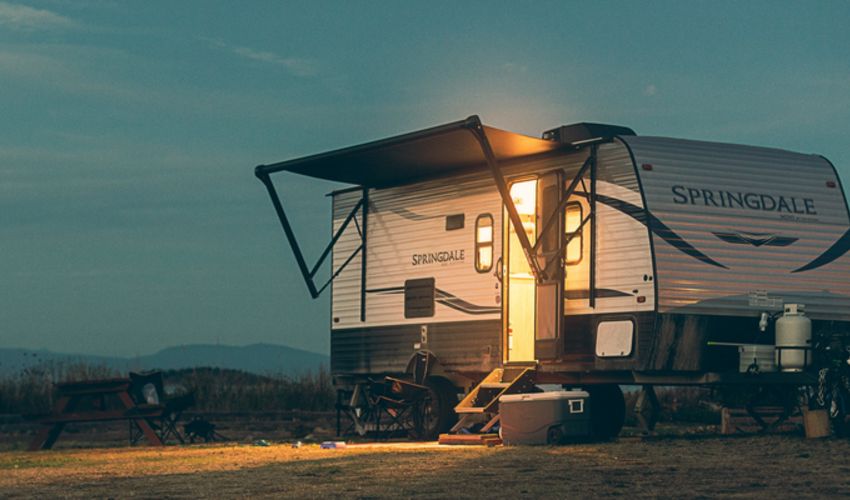Whether you buy your rig at an RV show or a dealership, there are a few steps between the transactional purchase and when you actually drive off the lot with your new RV. The following tips will help you prepare for your RV walkthrough at the dealership:

Expert Advice
Tips For Picking Up Your RV At The Dealership And Your RV Walkthrough
The process of taking home a new (or new-to-you) RV is a little more complicated than the process of buying a car — here’s what you need to know for your walkthrough at your RV dealership.
Understand the Behind-the-Scenes Process
Before you can take your new rig home, the dealership wants to ensure the RV is ready for you… and ensure that you’re ready for the RV.
-
The dealership needs to make sure the RV is ready for transfer:
First, the dealer must do a PDI (Pre-Delivery Inspection) to confirm that the physical condition of the RV has been checked and that all systems are operational. Next, the dealer may need to install any requested options or items that are generally not on/in the rig while it sits on a lot (i.e. televisions, propane tanks, and upgraded air conditioners).
-
Your dealership should schedule a complete RV walkthrough with you:
And when we say complete, we mean complete. The walkthrough can take several hours, so your RV dealership will have to schedule it at a convenient time for both parties. The tips in the final section of this post will help you make the most of this experience.
Consider Your Gear And Equipment
When RV owners think about gear and equipment, they’re tempted to focus on the fun stuff like patio lights, camp chairs, and colorful décor. However, there are more important safety and security items that are necessary.
-
Make sure your tow vehicle is properly outfitted for towing:
You’ll want to double-check all of your specs: Tow capacity, hitch weight, payload, and more all come into play. Some vehicles don’t come equipped with trailer brake controls or proper towing hitches. Figuring this out before you arrive to pick up your rig will save you the time and extra expense of finding out too late.
-
You may need a weight distribution and sway setup:
You may think weight distribution and sway bars are an unnecessary additional cost, but if you have a longer and/or heavier rig they’re likely necessary safety items. If you don’t bring in your own safety equipment, you’ll need to buy it at the dealership before you can take it off the lot. These additional expenses can sometimes be added to your loan if you are financing the RV — research your options and reasonable cost estimates before you go.
-
Purchase the necessities:
Before your first camping outing, you’ll need a good sewer hose and proper connectors, a water pressure regulator, a good surge protector or EMS (electrical management system), and power converters (to allow you to move between 50 amp, 30 amp, and 20 amp setups, as appropriate). Brace yourself for these additional costs, so you won’t feel shell-shocked on pick-up day.
Make The Most Of Your RV Walkthrough
A proper RV walkthrough will lead to many happy trips ahead but a rushed or incomplete walkthrough will lead to tons of frustration. Most importantly, you don’t want to get your RV all the way home and then discover several reasons why you need to take it back.
-
Record everything on your smartphone in individual files you can label for reference:
Don’t record the whole RV walkthrough in one swoop or you’ll be left searching through an hours-long video. Instead, make a short video of the hitching process, one for tank maintenance, one for fridge operations, and so on. Don’t be embarrassed — you’ll be thankful for these videos in the months and years ahead. If there are two people, one person can focus more on filming while the other focuses more on listening to the technician.
-
Make sure the service technician shows you everything, and we mean everything:
Don’t be afraid to ask lots of questions. If the RV technician points at something, feel free to ask them to explain how exactly it works. It’s much better to try to figure out the propane heating system with the help of a technician instead of wrangling with it on a cold night with no backup help. It’s also advised to ask about maintenance for all of your RV systems as well.
RELATED: Common RV Maintenance Tips -
Put the RV through the paces:
The RV dealership may have your rig set up when you arrive, but you still need to learn how to perform the setup yourself. Ask the tech to allow you to open and close the awning, the slides, the stairs, etc. If the air conditioner and refrigerator are already on, turn them off and start them again. Also, if your rig comes with electric awnings, stabilizers, or other motorized elements, learn how to manually operate each, in case of a power outage or other problem.
-
Inspect everything:
Inspect every nook and cranny of the exterior and interior. The RV manufacturer may have missed small items or others may have come loose during transportation. Inspect all the RV systems. Attach a water hose and run the sinks, toilet, and shower; look underneath for leaks. The most common complaint we hear from new RV owners is that they discover a leak during a trip and have to schedule a time to take the RV back for repairs. Even if the rig is winterized, don’t skip this step. The dealership may be able to fix several items right away.
-
Prepare for towing:
Don’t focus your entire walkthrough on your new rig — you should also bring your tow vehicle with you and practice setting up and using the weight distribution, sway system, and trailer brakes before pulling away.
RELATED: Getting Started RVing: Tips for Overcoming a Fear of Towing -
Plan a “shakedown” trip:
Don’t haul your rig across the country without doing a shakedown trip first. Camp close to home or in the driveway (but don’t run the AC unless you have a 30 amp hookup) and test out all of the RV systems to make sure you can operate everything independently.

This is a lot to take in all at once, but it’s better to take your time on pick-up day in order to have smoother processes later. Take the time to become familiar with your new RV before you hit the road. Before long, you’ll be operating your new RV like a pro.










